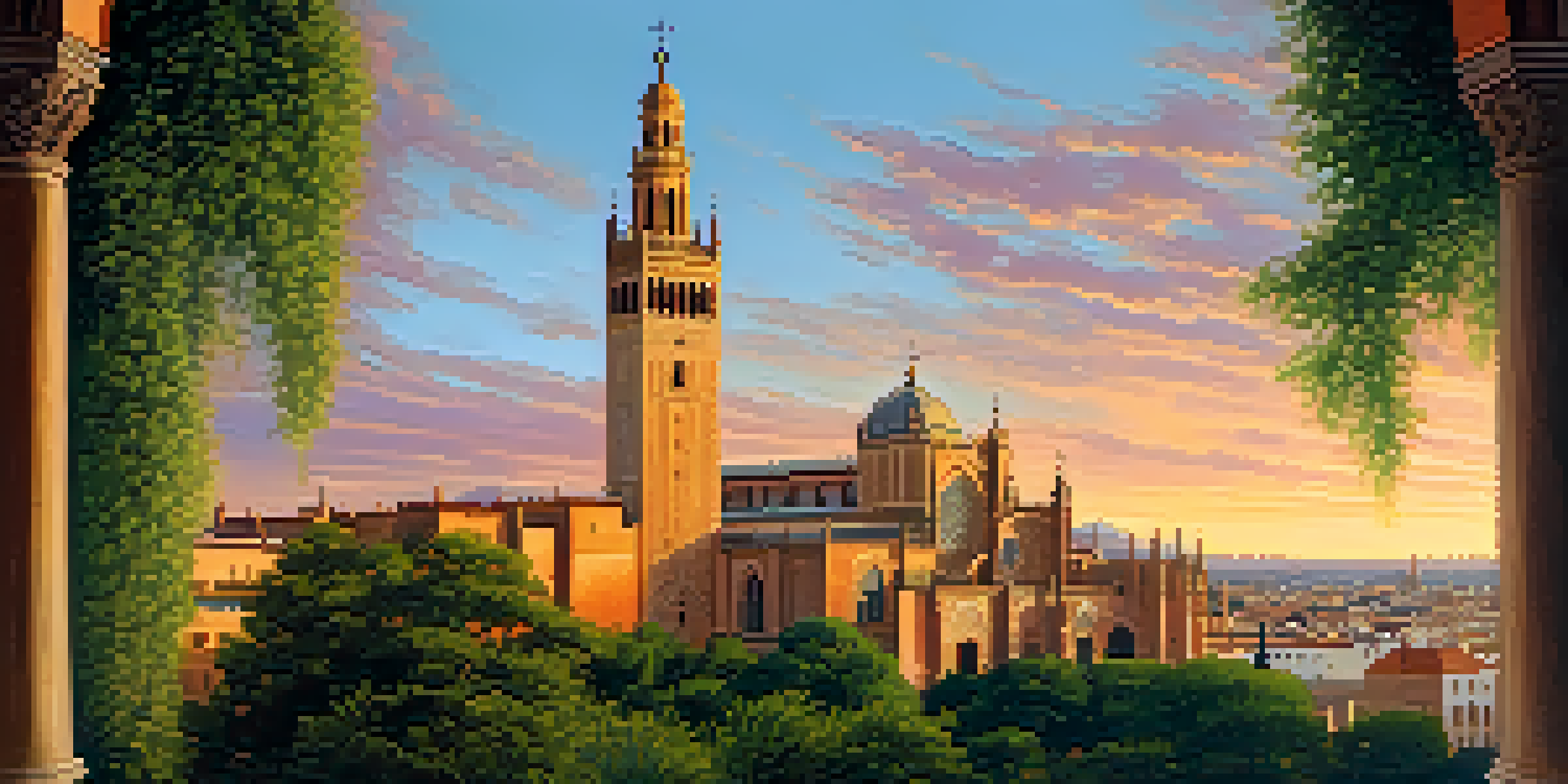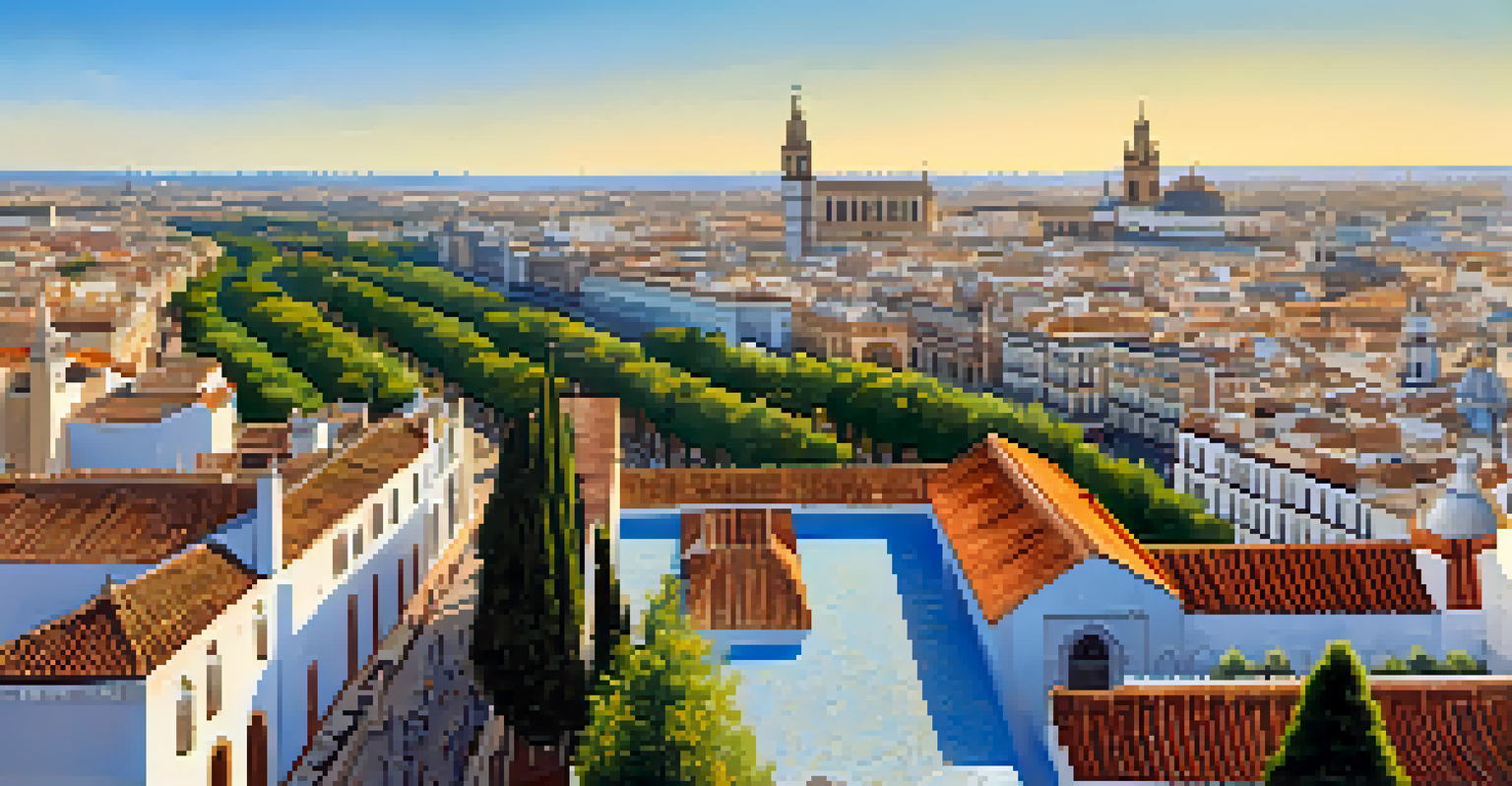The Historical Importance of the Cathedral of Seville

A Brief Overview of the Cathedral's History
The Cathedral of Seville, officially known as the Cathedral of Saint Mary of the See, boasts a fascinating history that dates back to the early 15th century. Originally built on the site of a former mosque, the cathedral reflects the religious and cultural shifts that shaped Seville over the centuries. Its construction began in 1401, with the aim of showcasing the city's wealth and power during the Reconquista.
A building is not just a building; it is a testimony of its time and place.
The transition from a mosque to a cathedral symbolizes the broader changes in Spain's history, particularly the Christian reconquest of Muslim territories. This transformation highlights the architectural fusion that characterizes many historical buildings in Spain. As a result, the Cathedral of Seville is not only a place of worship but also a testament to the city's complex past.
Over the years, the cathedral has undergone several renovations and expansions, each adding layers to its historical significance. By the time it was completed in 1506, it had already become a focal point for both religious and civic life in Seville. Today, it stands as a UNESCO World Heritage Site, drawing millions of visitors eager to explore its storied walls.
Architectural Marvels: Gothic and Mudejar Styles
One of the most striking features of the Cathedral of Seville is its unique blend of Gothic and Mudejar architectural styles. The Gothic elements are predominantly visible in the soaring ceilings and intricate ribbed vaults, which create a sense of grandeur and awe. Meanwhile, the Mudejar influences are evident in the use of decorative tiles and intricate plasterwork, showcasing the artistry of the Moorish builders.

This architectural fusion is a reflection of Seville's diverse cultural heritage, where Christian and Islamic designs coexist in harmony. For instance, the famous Giralda tower, originally a minaret, exhibits a seamless combination of both styles, serving as a visual representation of the city's historical evolution. As visitors admire these features, they can truly appreciate the craftsmanship that went into creating such a monumental structure.
Historic Significance of the Cathedral
The Cathedral of Seville, built on a former mosque, reflects the city's rich history and cultural evolution since the early 15th century.
The cathedral's design not only serves aesthetic purposes but also fulfills practical ones, allowing for a large congregation space while maintaining a sense of intimacy. This balance is one reason why the Cathedral of Seville remains a vital center for religious activities and community gatherings. It's a space where history, faith, and artistry converge, leaving a lasting impression on all who enter.
Significance in Christian Worship and Pilgrimage
The Cathedral of Seville holds immense significance as a center of Christian worship and pilgrimage. It serves as the seat of the Archdiocese of Seville, making it a pivotal location for spiritual leadership within the region. Regular services, special masses, and religious celebrations draw both locals and visitors, solidifying its role as a vibrant place of faith.
The architecture of any city is a reflection of its culture and history.
Beyond its local importance, the cathedral is also a destination for pilgrims from around the world. Its grandeur and historical significance attract those seeking spiritual enrichment or simply wanting to witness its beauty firsthand. Annual events, such as the Feast of Corpus Christi, highlight the cathedral's role in the community and its ability to bring people together in celebration of their faith.
This blend of local devotion and international interest underscores the cathedral's importance not only as a religious site but also as a cultural landmark. The stories and experiences shared within its walls contribute to a deeper understanding of the region's spiritual heritage. For many, a visit to the Cathedral of Seville is about more than just sightseeing—it's an exploration of faith, culture, and history.
Cultural Impact on Seville and Beyond
The Cathedral of Seville is not just a religious structure; it has significantly influenced the cultural landscape of Seville and beyond. As one of the largest cathedrals in the world, it has become a symbol of the city's identity and pride. The cathedral's stunning architecture and rich history inspire countless artists, musicians, and writers, making it a muse for creative expression.
Events held at the cathedral, such as concerts and art exhibitions, further enhance its cultural relevance. These gatherings not only celebrate the arts but also connect the community, fostering a sense of belonging and shared heritage. The cathedral's presence in popular culture, from films to literature, underscores its status as an iconic landmark that transcends religious boundaries.
Architectural Fusion of Styles
The cathedral showcases a unique blend of Gothic and Mudejar architectural styles, symbolizing Seville's diverse cultural heritage.
Moreover, the cathedral's influence extends beyond Seville, drawing international attention and tourism. Visitors from all corners of the globe come to marvel at its beauty and learn about its history, contributing to the local economy and promoting cultural exchange. This ongoing engagement with the cathedral highlights its role as a bridge between the past and present, enriching both the city and its visitors.
Preservation Efforts and Challenges
As a UNESCO World Heritage Site, the Cathedral of Seville is subject to various preservation efforts aimed at maintaining its structural integrity and historical significance. These initiatives include regular maintenance, restoration projects, and research to understand the building's materials and construction techniques better. Such efforts are crucial, given the wear and tear that comes with age and the impact of environmental factors.
However, preservation is not without its challenges. The influx of tourists can sometimes lead to overcrowding, which poses risks to the delicate artwork and architecture. Striking a balance between accessibility for visitors and the need to protect this historic site is an ongoing concern for local authorities and conservationists alike.
Despite these challenges, the commitment to preserving the Cathedral of Seville remains strong. Community involvement, public awareness campaigns, and funding support play vital roles in ensuring that this magnificent cathedral continues to be a source of inspiration and reverence for future generations. By safeguarding its legacy, we honor the generations that built it and those who continue to cherish its beauty.
Artistic Treasures Within the Cathedral
Inside the Cathedral of Seville lies a treasure trove of artistic masterpieces that speak to its historical and cultural significance. From stunning altarpieces to intricate sculptures, the cathedral showcases the work of renowned artists and craftsmen throughout the centuries. One highlight is the Main Altarpiece, a breathtaking example of late Gothic art that captivates visitors with its detailed carvings and vibrant colors.
In addition to the Main Altarpiece, the cathedral houses numerous chapels, each adorned with unique artwork that reflects different aspects of Christian faith and local patronage. These artistic treasures tell stories of devotion and creativity, allowing visitors to appreciate the deep connection between art and spirituality. The use of gold leaf, intricate woodwork, and vibrant stained glass creates a sensory experience that enhances the overall atmosphere of the cathedral.
Cultural Impact and Community Role
Beyond being a religious site, the Cathedral of Seville serves as a cultural landmark, inspiring artists and fostering community connections.
As visitors wander through the cathedral's interior, they are not only observing art but also engaging with history. Each piece of artwork serves as a reminder of the cultural exchanges and artistic influences that have shaped Seville over the centuries. These masterpieces contribute to the cathedral's allure, inviting contemplation and admiration from all who enter its hallowed halls.
Visitor Experience: What to Expect
Visiting the Cathedral of Seville is an experience that combines awe, education, and spiritual reflection. Upon arrival, visitors are greeted by the impressive façade and the towering Giralda, which invites exploration. Inside, the grand nave and intricately designed chapels create an atmosphere that encourages contemplation and appreciation of the architectural beauty surrounding them.
Guided tours are available, providing insights into the cathedral's history, art, and architecture. These tours allow visitors to connect with the stories behind the building, enhancing their understanding of its significance. Additionally, the opportunity to climb the Giralda tower offers breathtaking panoramic views of Seville, making it a must-do for any traveler.

Whether you're drawn by faith, history, or architecture, the Cathedral of Seville promises a memorable experience. The blend of stunning visuals and rich narratives creates an engaging environment for visitors of all backgrounds. Each visit serves as a reminder of the cathedral's enduring legacy and its role as a cultural and spiritual beacon in the heart of Seville.